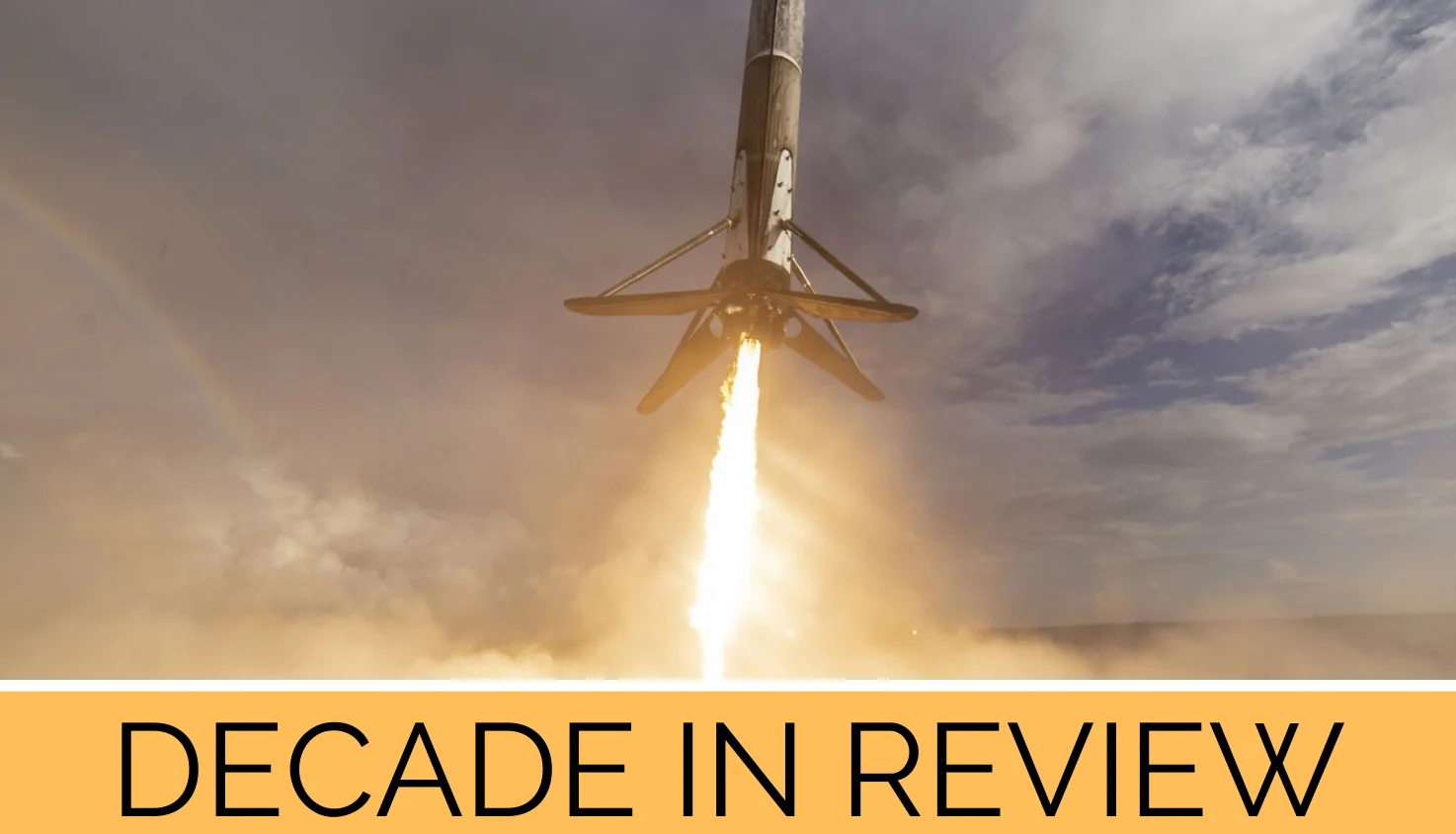
DECADE IN REVIEW: The top 10 Space stories of the past 10 years
So much has happened in astronomy and space over the past decade
The turn of the decade is upon us, and looking back of the past 10 years, there have been so many amazing achievements in space exploration and so many incredible astronomical events.
Actually ranking these on any sort of scale, to find out which is the best of all, would be difficult, to say the least. Instead, here are the top 10 space stories of the past decade, in chronological order.
NASA LANDS A NUCLEAR-POWERED ROBOT ON MARS
On the night of August 5-6, 2012, we all watched as a few dozen NASA scientists and engineers jumped up and down, high-fived, cheered and hugged, as their latest Mars rover, Curiosity (aka the Mars Science Laboratory), confirmed that it had successfully set down on the surface of the Red Planet.
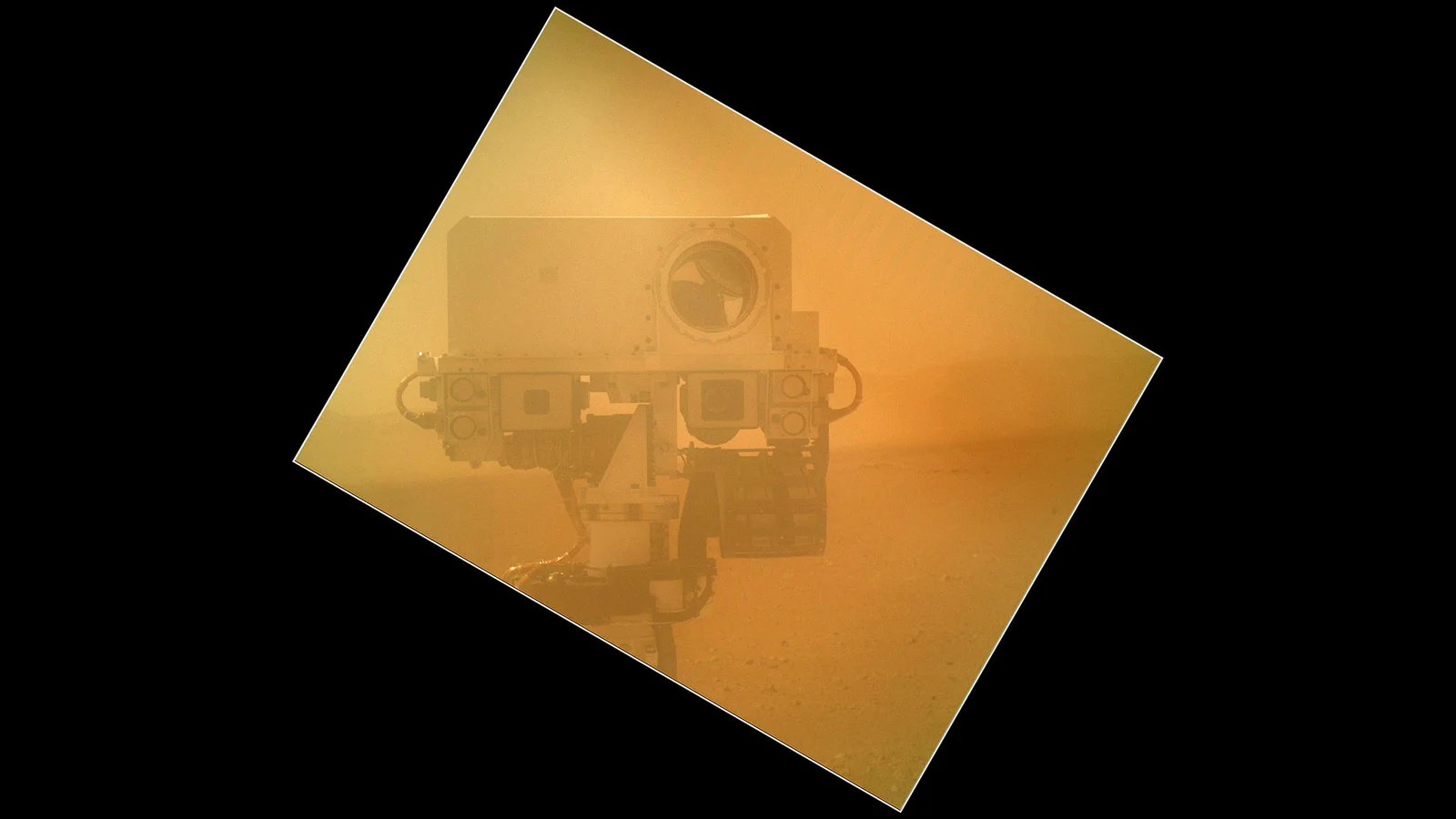
This very first 'selfie' image by Curiosity was taken on September 7, 2012, a month after the rover touched down on Mars. Credit: NASA/JPL-Caltech
NASA had tried some gutsy landings on Mars before, from the powered descents of the Viking and Phoenix landers, to the air-bag-assisted bounce-and-roll touchdowns of Pathfinder and the Opportunity and Spirit rovers.
By comparison, Curiosity's landing was over the top, though! Due to the mass of this car-sized rover, it required a brand new, never-before-tried method of touchdown. The absolute perfect timing and coordination of this landing - which the computer had to perform all on its own, with no guidance at all from Earth during the whole process - had the entire NASA team, as well as everyone watching, on the edge of their seats.
This nail-biting maneuver was nicknamed Curiosity's "Seven Minutes of Terror".
Not only did this landing succeed, but it only took Curiosity roughly seven months to complete its primary mission on Mars! In March of 2013, NASA scientists reported that the rover had discovered evidence in clay samples that the planet once had conditions that could have supported microbial life!
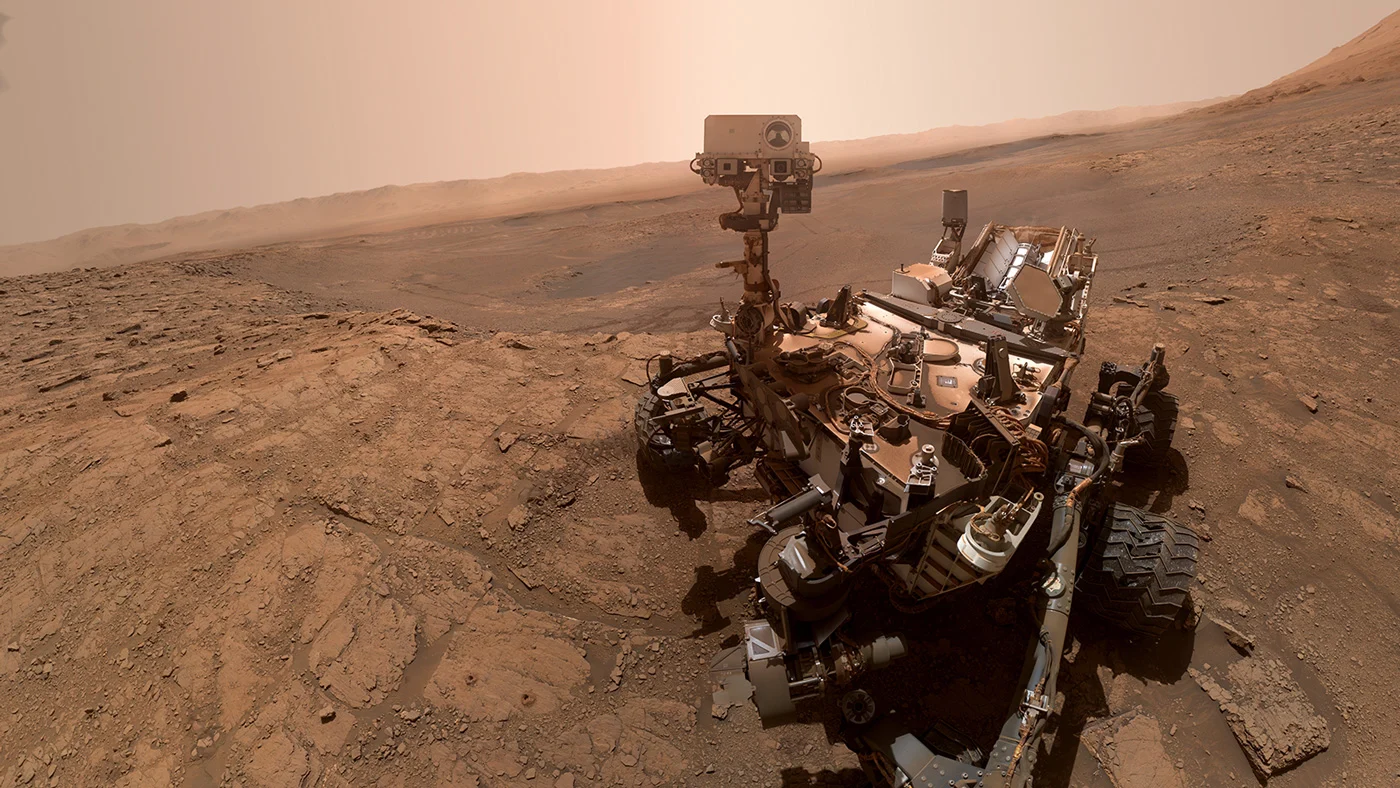
Curiosity snapped this full-rover selfie panorama on October 11, 2019, at the location on the slopes of Mt Sharp nicknamed "Glen Etive." Credits: NASA/JPL-Caltech/MSSS
Curiosity continues to explore Gale Crater, to this day, making the slow climb towards the summit of Mount Sharp in its quest for more scientific discoveries!
HUMANITY'S FIRST INTERSTELLAR SPACECRAFT
Humans have launched plenty of spacecraft, sending them to explore planets, moons, comets and asteroids... even the Sun! Until August 25, 2012, though, every one of those spacecraft had only been in interplanetary space, inside the sphere of influence of our Sun.
On that date, the Voyager 1 probe, after flying away from the Sun for nearly 35 years, became the very first spacecraft to leave the heliosphere, and enter interstellar space!
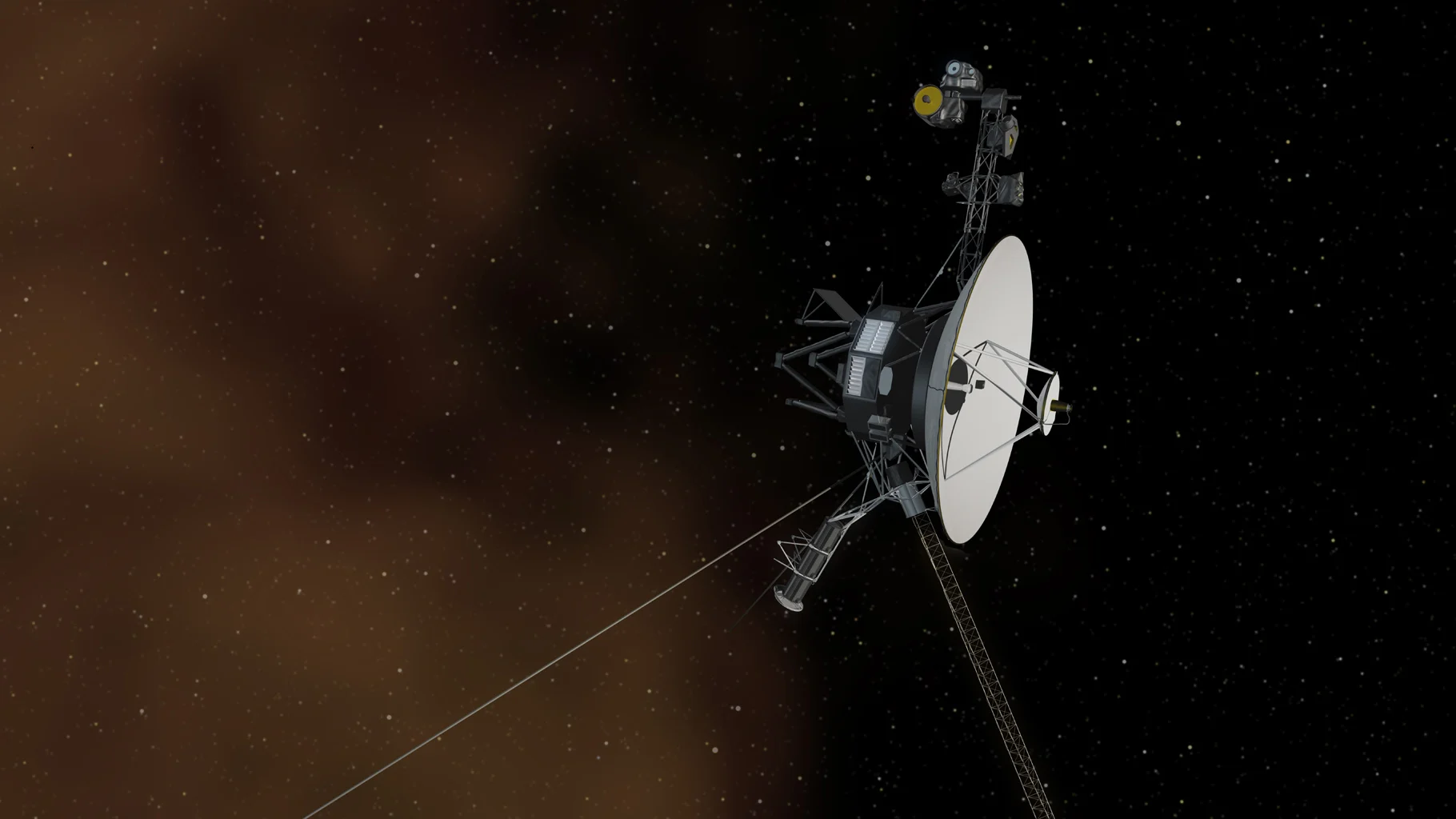
This artist rendition of the Voyager 1 spacecraft shows it entering the interstellar medium. Credit: NASA/JPL-Caltech
Even after 40 years now in space, Voyager 1 is still sending back data, telling us what it's like beyond the heliosphere, and it was joined there by its twin, Voyager 2, as of November 5, 2018.
FIRST LANDING ON A COMET
NASA is not the only space agency trying for gutsy landings over the past decade. Back in November of 2014, the European Space Agency's Rosetta spacecraft released its tiny lander, named Philae, for the very first landing attempt on the surface of a comet!
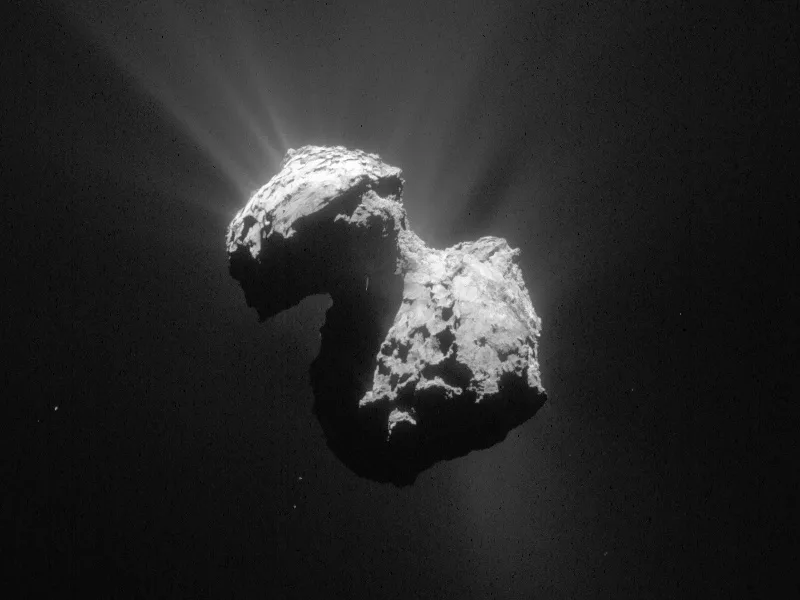
Comet 67P/Churyumov–Gerasimenko as imaged by the ESA's Rosetta spacecraft on July 7, 2015. Credit: ESA/Rosetta/NAVCAM
Now, everything did not go entirely according to plan on this attempt. As Philae touched down, it was supposed to fire a pair of harpoons from its underside, which were to embed into the icy surface to secure the lander in place. Unfortunately, the harpoons did not deploy properly, and Philae ended up bouncing across the surface for several kilometres, coming to rest in a dark crevase.
While the mission team got three days of data out of Philae, which allowed them to perform some of the tests the lander was responsible for, the lack of sunlight at its location resulted in it shutting down. It took nearly two years for them to track down Philae's final resting place in Rosetta's surface imagery.
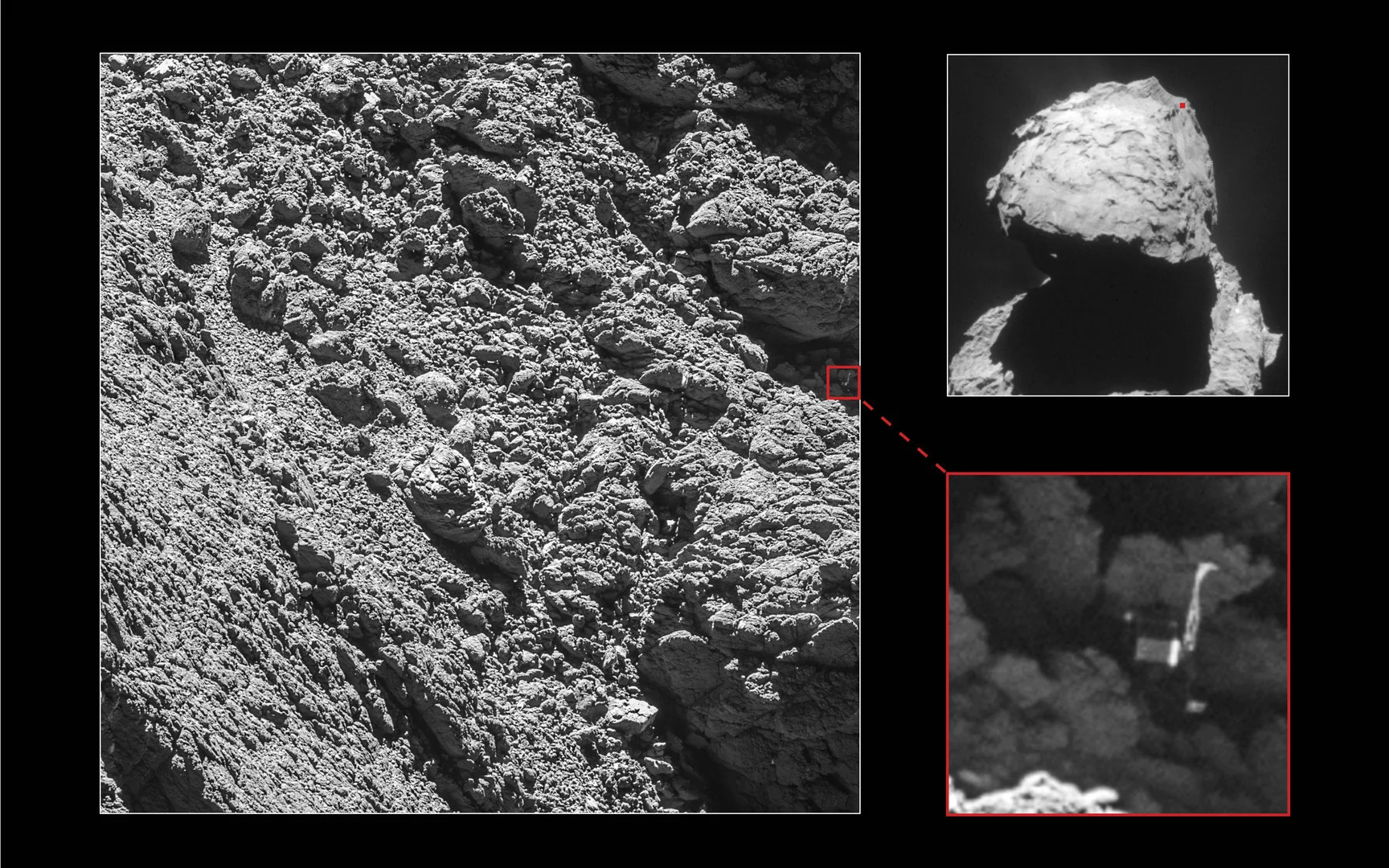
Philae's location is shown in these three images. The left image shows the craggly terrain the lander became stuck in, with the small inset to the lower right showing a close-up of Philae. To the upper right, the red dot indicates where on Comet 67P this is. Credits: Main image and lander inset: ESA/Rosetta/MPS for OSIRIS Team MPS/UPD/LAM/IAA/SSO/INTA/UPM/DASP/IDA; context: ESA/Rosetta/NavCam
FINALLY SEEING PLUTO
Pluto was first discovered in 1930, when astronomer Clyde Tombaugh spotted it as a tiny moving dot using the telescope at the Lowell Observatory. It took until 1996, with the launch of the Hubble Space Telescope, for us to get a better look at this distant world, but even that only showed us a small blurry circle.
On July 14, 2015, however, NASA's New Horizons spacecraft, after a ten-year journey into the outer solar system, finally gave us a close-up look at this distant world!

Images of Pluto (lower right) and its largest moon Charon (upper left) taken by NASA's New Horizons spacecraft on July 14, 2015. In these enhanced colour photographs, Pluto and Charon are shown with approximately correct relative sizes, but their true separation is not to scale. Credits: NASA/JHUAPL/SwRI
The encounter was a brief one, due New Horizon's incredible speed making it impossible to slow down and fall into an orbit around the Pluto-Charon system. The number of images snapped of both objects, and the other four tiny moons in the system, scientists will still be studying them all for years to come. There has even been talk, recently, of sending a new mission that would actually stop and explore there, further!
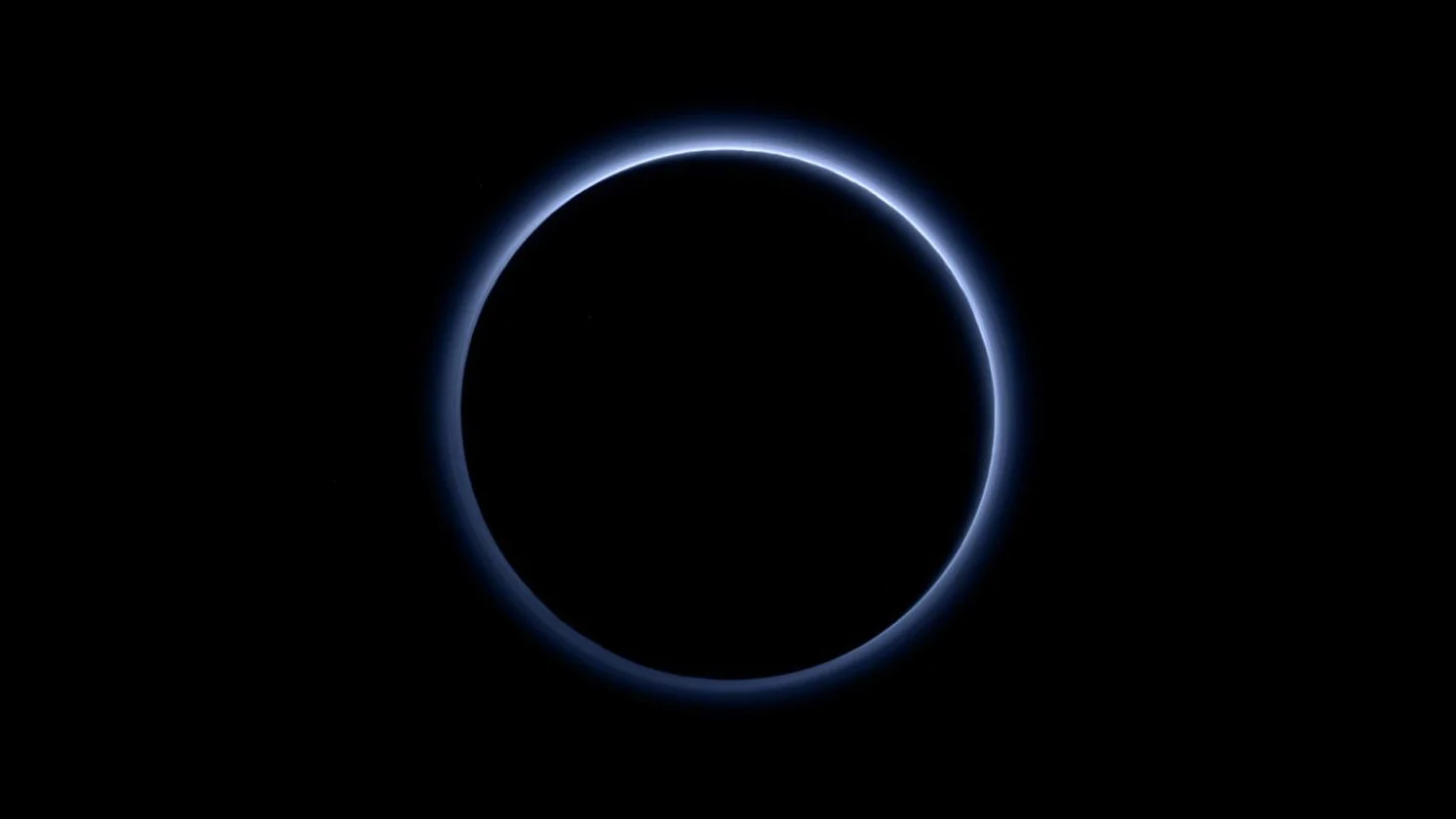
Post flyby, New Horizons turned around and pointed its cameras at the dark side of Pluto, capturing its back-lit atmosphere. Credits: NASA/JHUAPL/SwRI
AN OCEAN UNDER ENCELADUS' ICY CRUST
NASA's Cassini spacecraft spent 13 years at Saturn, snapping images of the planet, its rings and its numerous moons. On September 15, 2015, roughly two years before the end of its mission, NASA made a remarkable announcement.
Based on the data and pictures Cassini had sent back to Earth, scientists had determined that there was a global ocean on Saturn's moon Enceladus, trapped under a kilometres-thick crust of ice.
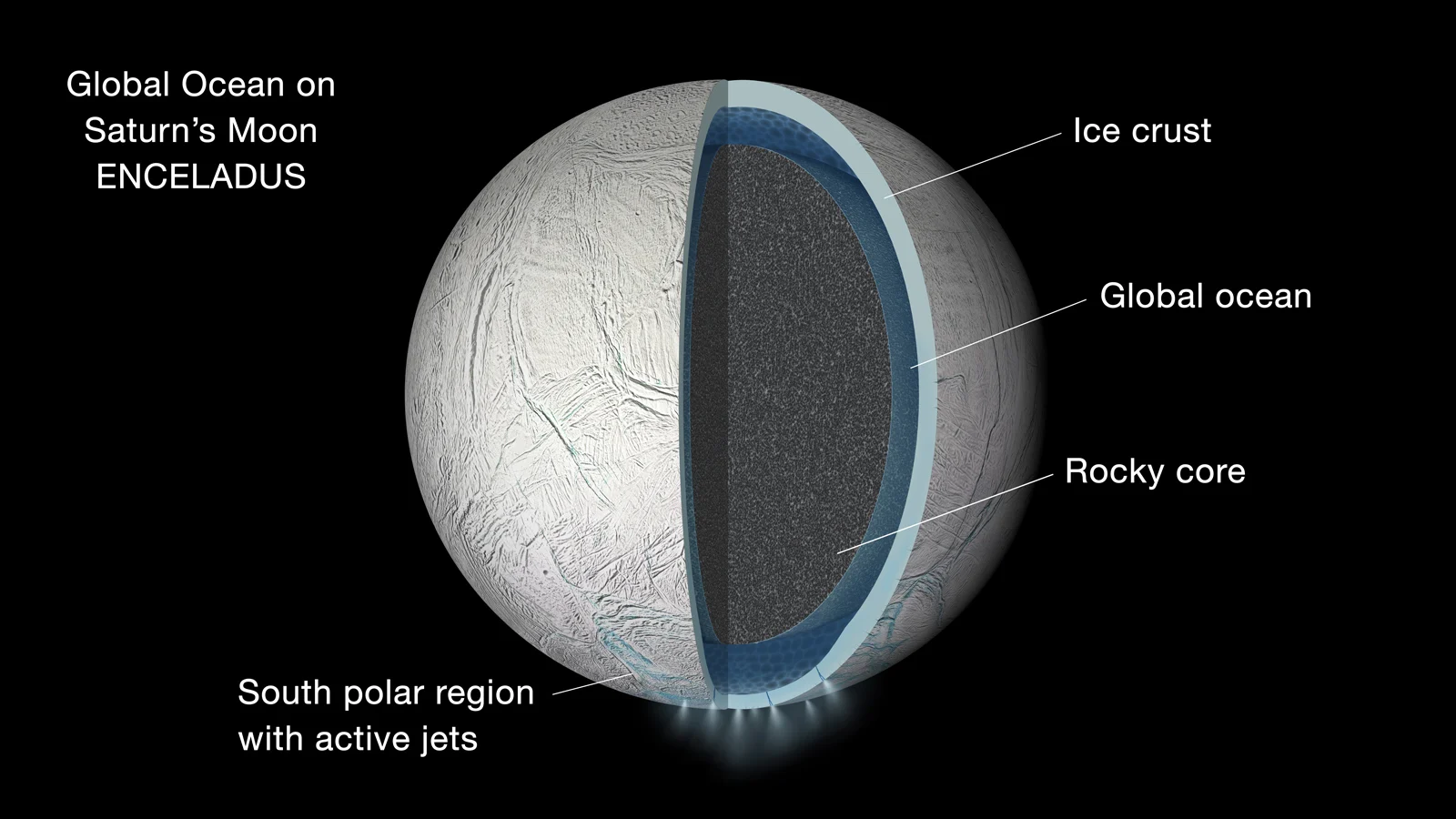
Illustration of the interior of Saturn's moon Enceladus showing a global liquid water ocean between its rocky core and icy crust. Thickness of layers shown here is not to scale. Image credit: NASA/JPL-Caltech
Why is this so important?
If there's a global ocean of liquid water under the surface of Enceladus, it is likely kept warm due to 'tidal heating' of the moon, as Saturn's gravity causes the rocky core to squeeze and stretch on each orbit. Plus, Cassini flew straight through the plumes of water vapour that are ejected from Enceladus' south pole, and it detected organic molecules.
That doesn't necessarily mean there's life there - 'organic' molecules are simply ones that contain carbon atoms - but subsequent studies found that there could be enough nutrients and energy in Enceladus' ocean to support life.
That potentially makes this icy Saturnian moon one of the most likely places for us to find alien life!
THE AGE OF REUSABLE ROCKETS BEGINS!
Classic 1950s sci-fi movies had some laughable plots and special effects compared to what we see now, but they certainly got one thing right! In the future, we would have rockets that could blast off, make a vertical landing back on Earth, and then be able to take off again for the next mission.
Elon Musk's SpaceX made this a reality on December 21, 2015, when their Falcon 9 booster rocket made a successful vertical landing at Cape Canaveral, after lifting nearly a dozen satellites into orbit.
That particular rocket booster has not made another trip into space, as it currently adorns the front lot of SpaceX headquarters in Hawthorne, Calif., but several Falcon 9 rocket boosters have now made multiple trips to space and back. Currently, SpaceX has four Falcon 9s that have launched and landed three times, so far (one of which is waiting for its fourth mission, scheduled in January of 2020). Another booster has already made its fourth successful trip to orbit and back, on November 11, 2019, and presumably will be capable of more.
All of this reusability is bringing down the cost of launching missions into space. It will still be some time before the costs come down enough for anyone to make the trip, but we are definitely on the way.
RIPPLES IN THE FABRIC OF SPACETIME
For years, scientists and engineers have been trying to open up a new branch of astronomy, one that would detect some of the most extreme events in our universe.
On February 11, 2016, astronomers working with two special observatories here on Earth reported that they had finally made their very first detection of gravitational waves.
Very similar to how ripples move along the surface of a pond after a pebble is dropped into the water, gravitational waves are ripples in the very fabric of spacetime. Since you can't simply 'drop' something into space, though, these spacetime ripples form during extreme events, such as when black holes and neutron stars merge with each other.
It was nearly five months earlier, on September 14, 2015, that the Laser Interferometer Gravitational-Wave Observatory (LIGO) in the United States and the Virgo gravitational wave interferometer in Italy, actually detected the spacetime ripples as they swept past Earth. It took those five months to actually confirm that what the astronomers saw was an actual real signal of gravitational waves, and to trace the ripples back to their source.
They determined that the event that caused the ripples was two massive black holes spiraling in towards each other and then finally merging.
It is estimated that these two black holes, which measured as 35 and 30 times the mass of the Sun, respectively, merged around 1.4 billion light years away from us (in another galaxy).
Since that first detection, LIGO and Virgo have picked up 10 more gravitational wave events (including the amazing Kilonova event in 2017), and there is a longer list of candidates that astronomers are working to confirm!
THE BEST SOLAR ECLIPSE
On August 21, 2017, we witnessed the best solar eclipse of the decade, as the Moon's shadow passed directly over North America.
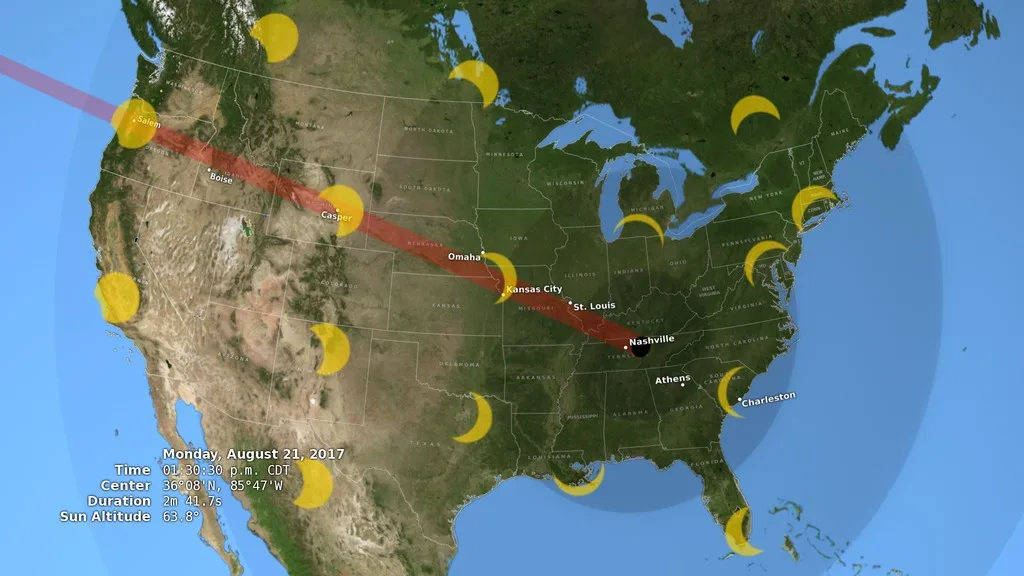
A map of the August 21, 2017 total solar eclipse path of totality, across the United States. The various crescents represent how much of the eclipse was seen from different locations away from the path of totality. Credit: NASA GSVS
The views from the eclipse's 'path of totality' were absolutely breathtaking.
Another solar eclipse this good, at least for those of us in Canada and the United States, won't happen until April 8, 2024, with an annular eclipse passing over the US Southwest in October of 2023.
FIRST VISITOR FROM INTERSTELLAR SPACE
Scientists have speculated for years that objects from beyond our solar system could be flying right past us, all the time, and we just didn't have the technology to see them.
That changed on October 26, 2017, when telescopes spotted object 2017 U1, which appeared to be an asteroid travelling so fast through our solar system that there's no way that it could be from around here. It was the very first detected interstellar object - an asteroid or comet that originated in an alien solar system and was somehow ejected out into the galaxy, millions of years ago.
Renamed 1I/2017 U1, to designate it as the first interstellar object, it was also given a nickname - ʻOumuamua, which roughly translates to "first distant messenger" from the Hawaiian language.
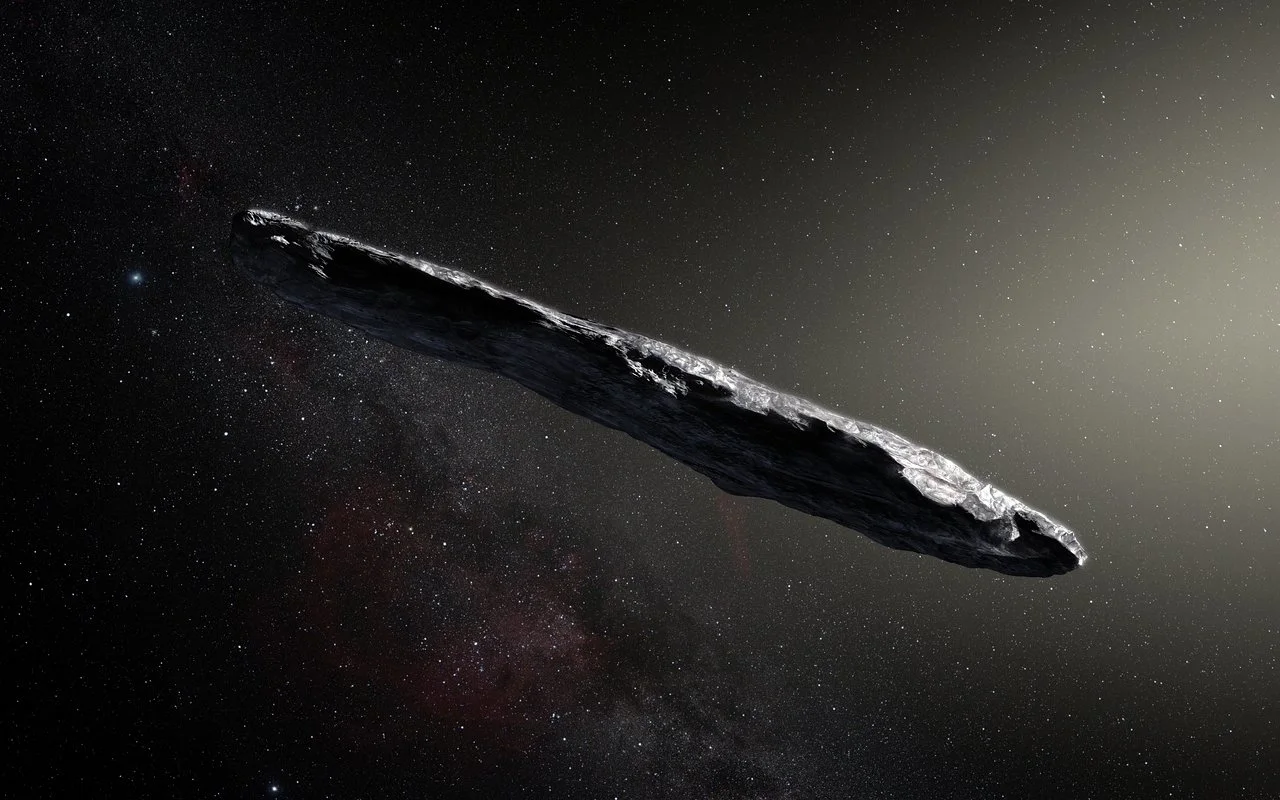
Interstellar asteroid(?) 'Oumuamua is pictured here in this artist's impression. It was found to be long, thin and probably flat, with a similar shape to a skipping stone. Credit: ESO/M. Kornmesser
Searching for its point of origin, astronomers showed that, most likely, 'Oumuamua had traversed a good portion of the galaxy to reach us, and possibly even circled the galaxy a few times in the process.
'Oumuamua was weird, too! Based on the reflected sunlight astronomers picked up from it, the best fit for 'Oumuamua's shape seemed to be that of a flat disk, kind of like a rough-edged skipping stone. Who knows what interactions it went through, during its formation or on its long journey to meet us, to produce that shape? It also was observed to change speed and direction, ever so slightly, as it was heading away from the Sun! Comets are known to do this, due to gases ejected from the nucleus, but no such activity was observed from 'Oumuamua. This fact had one astronomer speculating that it may not have been a natural object, but instead it could have been an alien solar sail!
Unfortunately, we'll never know exactly what 'Oumuamua was, or exactly where it originated. Since its discovery, though, astronomers have also spotted a second interstellar object, and this one is obviously a comet!
FIRST IMAGE OF A BLACK HOLE
When the most massive stars in the universe reach the end of their 'lifespan', they die rather spectacularly. Their outer layers are blown off in an explosion known as a 'supernova', leaving behind a dense core of matter that crushes down from the width of our Sun to a single point in space, all within the blink of an eye. The gravity near this stellar remnant is so strong that once you get close enough - the object's 'event horizon' - there is no escape. Not even light can travel fast enough to break away (and that's the fastest speed in the universe).

This artist's impression depicts a rapidly spinning supermassive black hole surrounded by an accretion disc. Credit: ESO, ESA/Hubble, M. Kornmesser/N. Bartmann
So, with light unable to escape, it's understandably difficult to actually see a black hole. Up until 2019, astronomers could only 'see' them indirectly. They could detect radiation emitted by matter spiralling around the black hole, or they could see how the black hole's gravity affected objects around it (such as other stars).
On April 10, 2019, though, astronomers working with the Event Horizon Telescope project gave us what amounts to the closest we'll ever get to actually seeing a black hole.
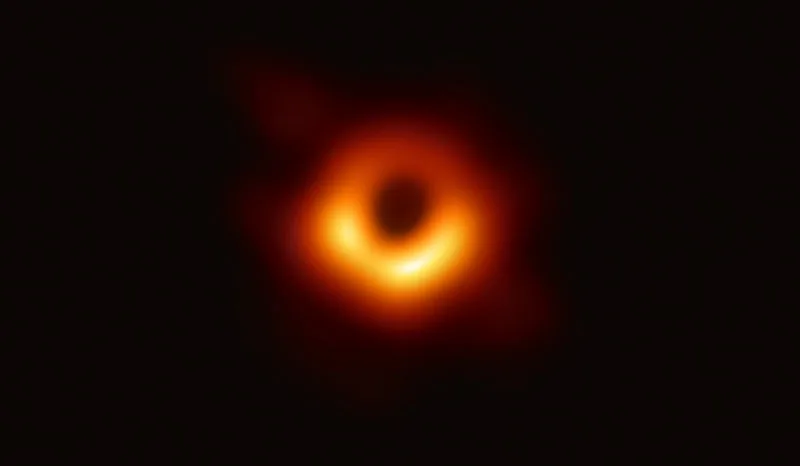
This first-ever image of a black hole, captured using the Event Horizon Telescope, shows the supermassive black hole that lies at the centre of the galaxy M87. Credit: Event Horizon Telescope Collaboration
What we're seeing in the above image is the glowing disk of plasma that is spiralling around the supermassive black hole that lies at the heart of galaxy M87, located around 53 million light years away in the constellation Virgo. The dark region in the middle is the shadow cast on that plasma by the black hole's event horizon. The event horizon, itself, is roughly 2.5 times smaller, located in the core of that shadow.
One of the most amazing things about this discovery? Astronomers had to essentially use a radio telescope as big as the Earth, to accomplish it!










